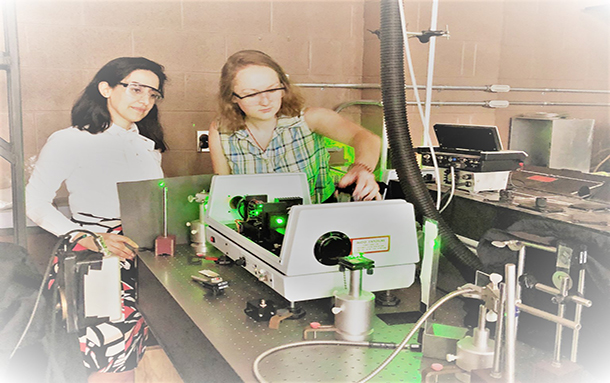- July 17, 2019
- Applied Research
- Comments : 0
Pushing solar energy forward with Dr. Zahra Khatami
Solar cells are everywhere you look these days.
Laid out in panels on your neighbors’ roof. Powering phone chargers or streetlights. Replacing or supplementing conventional power supplies for communications and weather infrastructure. Even hanging off the side of the International Space Station like a hulking pair of reflective wings.
Photovoltaic cell technologies, meaning those that can convert light directly into energy using semiconducting materials, are becoming so efficient that some solar proponents have even envisioned a future‘solar economy’ where all our energy requirements are fulfilled by sunlight. Although in the past, this has been considered an overly optimistic view, research into solar cell composition and construction is advancing more quickly than ever toward legitimizing the possibility of worldwide solar coverage. And for that, we have researchers like Dr. Zahra Khatami at the University of New Brunswick to thank.
Educated in Physics at Shahid Beheshti University in Tehran and Engineering Physics at McMaster University in Hamilton, Dr. Khatami is at the forefront of research into how we can make LEDs and solar cells convert light into electrical energy more efficiently. Since joining the Department of Physics at UNB in 2018, she’s been working on optimizing the proper mix of silicon and other elements in nanostructured solar cells.
“Even after half a century, more than 80% of solar cells are silicon-based, mainly because silicon – the cornerstone material of computer chips – is cheap, abundant and can be fabricated using non-toxic processes,” says Dr. Khatami. “My independent project at UNB is based around developing new materials and silicon blends that increase efficiency by utilizing more light.”
Her experiments often focus on using elements like cerium, terbium, and europium to improve solar cell efficiency and facilitate easier conversion into energy. This work, centered around developing thin-film solar cells using novel silicon nanostructures, was the subject of an emerging project grant for $25k from the NBIF in 2018.
Although the main thrust of her theoretical research is in the field of experimental physics, Dr. Khatami notes that in order to fundamentally change the makeup of solar cells, she operates within the more practical realm of engineering physics. Though to hear her tell it, there was never much doubt in her mind what field she would go into.
“When I was in high school in Iran, I had so many questions,” she says. “Why is the sky blue? Why are people able to see different colors? It seemed that every question I had; physics was able to answer.”
Dr. Khatami sees an important place for New Brunswick in the emerging field of solar energy. Although prairie provinces like Saskatchewan and Manitoba typically top lists of the sunniest places in Canada, many people are unaware that New Brunswick has averaged more sunny days over the last 30 years than any of its maritime neighbors. This is great news for proponents of solar energy in this province, but Dr. Khatami admits that it can sometimes be a challenge to educate the public and their political leaders on the benefits of this new technology.
“In general, people don’t know the advantages of using solar cells. It’s an issue of practicability – you need to invest money at the start, but in the long term, solar energy pays off. Nanotechnology is undeniably part of our future, and solar is likely one of our strongest potential renewable energies. Globally, solar technology is predicted to be at the forefront of renewable energy efforts by 2030.”
While Dr. Khatami feels at home in the laboratory, she also recognizes the importance of the work she does in the classrooms of UNB, particularly in mentoring and supervising female students in a field long dominated by male scientists.
“I was one of the lucky ones,” she says, referring to her entry into the physics career path. “There are not many women in hard science. It’s changing, but we must remember that we are still behind. Physics and Engineering Physics is still catching up to fields like Astronomy, where women were consciously included and encouraged in the early days. Now the gender balance in that field is much more equal than it is in mine.”
As not only a woman but an immigrant as well, Dr. Khatami is a great example of how immigration can help increase the level of research expertise in New Brunswick. This year, NBIF recognized Dr. Khatami once again with a Research Assistantship Initiative award of $36k for work exploring the characterization of silicon light emitters for solid-state lighting. It is this type of research that helps put New Brunswick on the map and helps attract other foreign and domestic researchers and industries to our institutions and labs.
We are happy to support Dr. Khatami in her forward-thinking research, and we’re excited to see how that research helps us solve environmental problems, improve communications abilities, and diversify our provincial energy grid. We’re seeing some sunny days ahead…


